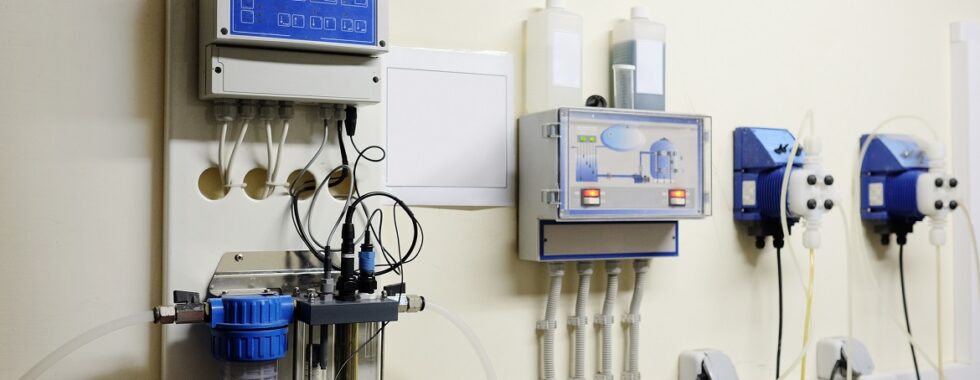Water disinfection
Water disinfection refers to the inactivation of microorganisms that are pathogenic to humans, animals or plants.
Inactivation involves destroying essential structures or altering essential functions of microorganism.
A microorganism is considered inactivated where:
- It is not capable of reproduction, i.e., it’s DNA or cell parts are damaged, and it cannot replicate itself.
- The microorganism cannot metabolize and cannot process nutrients.
Inactivation of pathogens
The water disinfection process is measured using the Log Removal Value (LRV) – a measure to the ability of the disinfection process to inactivate pathogens.
LRV = log10(C0 /Ct)
C0 – Concentration of pathogens at t=0
Ct – Concentration of pathogens at time t
A related index is the Percent Reduction (pR):
pR = (C0 – C) / C0
Where:
C0 – Concentration of the pathogen at t=0
Ct – Concentration of the pathogen at time t
The relation between percent reduction and log reduction can be described using the following equation:
pR = (1 – 10 -LRV) x 100
Therefore:
1-log reduction = 90% inactivation
2-log reduction = 99% inactivation
3-log reduction = 99.9% inactivation
4-log reduction = 99.99% inactivation
etc.
Water disinfection does not necessarily inactivate 100% of the microorganisms. It may usually achieve a log removal value of between 1 and 3.
Let’s see an example:
A bacteriophage concentration in the water is 106 mL-1.
Water disinfection achieved an LRV of 1.7.
What is the bacteriophage concentration in the effluent?
What is the percent of inactivation?
Solution:
LRV=log(C0/Ct)
log(C0/Ct)=1.7
C0/Ct=101.7 = 50.11
106/Ct=50.11
Ct=1.99∙104 mL-1,
pR = (1-10-1.7)x100 = 98%
Disinfection byproducts (DBP)
Disinfection with chlorine results in formation of harmful disinfection byproducts in the water. Many of them are considered carcinogens.
Disinfection byproducts are formed as a result of the reaction of the disinfectant with compounds in the water. These compounds are referred to as ‘Precursors’ and they consist mainly of NOM (natural organic matter) compounds and bromide.
Disinfectants that can form DBPs include chlorine, chloramines, chlorine dioxide and ozone.
The most predominant DBPs are Trihalomethanes (THMs) and haloacetic acids (HAAs).
Factors that affect the efficacy of the disinfection process
Many factors affect the efficacy of the disinfection process, and it is the combination of factors that will determine whether the disinfection will be efficient or not.
- The type of disinfectant used
- The concentration of the disinfectant
- Contact time between the disinfectant and the water
- Water temperature
- Water pH
- The microorganism to be eliminated
- The concentration of the microorganism in the water
- Mixing of the water
- Water quality – turbidity, NOM, Fe, Mn
The Chick-Watson model describes the effect some of these factors:
ln(N0 / Nt)= -rC nt
Where
N0 – Initial concentration of microorganism
Nt – concentration of microorganism at time =t
r – experimental constant
C – concentration of disinfectant
n – coefficient of dilution
t- time
The C∙t concept
The product of the residual concentration of the disinfectant and the contact time between the disinfectant and the microorganism is an important factor that determines the effectiveness of the disinfection process.
This can be explained using the Chick-Watson model:
n(N0 / Nt) = -rC nt –> -(1/r) n(N0 / Nt) = C nt
For a given level of survival fraction (Nt/N0), – is constant = K
K=C nt
Where,
When n>1 – disinfection depends on concentration
When n<1 – disinfection depends on contact time
However, n is usually set to 1
C∙t values are given in the literature for different pathogens and disinfectants. Values are given for specific temperatures and pH levels.
For example:
C∙t for 2-log inactivation of Giardia cysts by chlorine dioxide, at 15°C is 13 mg∙min/L.
Therefore:
for t=30 minutes –> C∙30=13 –> C=0.43 mg/l
For t=15 minutes –> C=0.86 mg/l
This means that a concentration of residual chlorine dioxide of 0.43 mg/l is required for a contact time of 30 minutes, but if the contact time is reduced to 15 minutes, then a concentration of 0.86 mg/l of chlorine dioxide is required.
Examples of free chlorine and contact time required to inactivate plant and human pathogens in irrigation water:
| Pathogen | Type | Pathogen of | Free chlorine (mg/L) | Contact time (min.) |
|---|---|---|---|---|
| Agrobacterium tumefaciens | Bacteria | Plants | 4.0 | 30 |
| Erwinia chrysanthemi | Bacteria | Plants | 1.0 | 1.0 |
| Fusarium oxysporum | Fungus | Plants | 14.0 | 6.0 |
| Pseudomonas aeruginosa | Bacteria | Humans, animals, plants | 100.0 | 10.0 |
| Bacillus anthracis | Bacteria | Humans, animals | 2.2 | 120.0 |
| Pythium aphanidermatum | Oomycetes | Plants | 2.0 | 3.0 |
Common water disinfection methods include the use of chemicals, such as chlorine, UV (ultraviolet), distillation and ozonation.
The C∙t concept can be applied to UV disinfection as well, where UV intensity is used instead of concentration.



